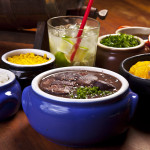 Feijoada, a savoury black bean and meat stew, is the most delicious of Brazil’s national treasures. This famous Brazilian combination of beans and rice with pork pieces has been a served up in Brazil since before the 16th century. This delicious meal is made so often and with such enjoyment that it is widely accepted as Brazil’s national dish. This rice, beans, and pork dish is both a comfort food and a good, nutritious and filling meal whether you’re having a huge crowd to dinner or just an intimate night for two.
Feijoada, a savoury black bean and meat stew, is the most delicious of Brazil’s national treasures. This famous Brazilian combination of beans and rice with pork pieces has been a served up in Brazil since before the 16th century. This delicious meal is made so often and with such enjoyment that it is widely accepted as Brazil’s national dish. This rice, beans, and pork dish is both a comfort food and a good, nutritious and filling meal whether you’re having a huge crowd to dinner or just an intimate night for two.
Feijoada and it’s history
The word feijoada stems from the word feijão means “beans” in Portuguese. Feijoada is made throughout Portugal in the regions of Beria, Estremadura, and Tras-os-Montes. But Brazilian feijoada has a flavour all its own. This black bean stew is simmered with a variety of salted pork and smoky pork spare ribs. This stew sometimes also includes lesser-used cuts of meat, such as pigs ears, tail, and feet. The thick, rich dish is traditionally served with garlic rice, collard greens, and a variety of other vegetables (Potatoes, cabbage, carrots, okra, kale, pumpkin, chayote and sometimes banana are known to be added in to enhance the flavour). The vegetables are steamed above the simmering pot, so that the rising aroma and flavours of the stews are cooked into the vegetables before they are added into the meal. Feijoada is savoury, spicy, rich, and flavourful and known all over Brazil for its good nutrition and excellent taste.
The stew simmers for hours until it reaches the perfect flavour, but feijoada has simmered much longer than that, in kitchens and over hot fires of Brazil since before the 16th century. The history of Feijoada began in sugar cane plantations, and it is believed to have been first made by the slaves who worked the fields. The long-believed tale is that slaves would leave beans cooking while they worked on the plantation. When they came back, exhausted from working, they would add in the scraps of meat that were considered too poor for their masters. While the origin of feijoada has a long history of being told in Brazil, recently, scholars disagree with the story. During the time the story takes place, historically scraps of meat were considered the best part of the meal. Scholars still credit the slaves for creating the delicious dish of feijoada, but they agree that they were probably making it for their masters.
While feijoada started out in the sugar cane fields of the 16th century, now the rich and savoury stew can be found on the menus of five star restaurants in the 21st century. But restaurants aren’t the only place that you’ll find this delicious meal being made. Traditionally, feijoada is made in Brazil on Saturdays as a meal to be shared by a large group of friends and family. Making feijoada is an act of love as it takes time and care to coax the spicy, rich flavours out of the beans and pork cuts. If your feijoada is still not spicy enough, add in some hot sauce, like many Brazilians regularly do. Or, if you’re a vegetarian, you can still enjoy feijao com arroz, which is a bean and rice stew, without the meat.



